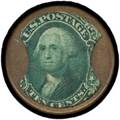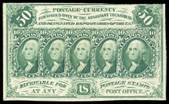
We all know about the civil war; Its savagery; The famous battles, the horrible prisoner of war camps and dislocation of hundreds of thousands of people. What is less know is the fact that the war created a rapid rise in inflation. This inflation, in turn, created a shortage of metal coinage because of hoarding. As the metal in the coins increased in value above the face value of the gold or silver in the coins, people began to hoard them. Many coins were melted down in order to obtain the actual inflationary value of the precious metals. By 1862 metal coins had virtually disappeared from public use. In July 1862 the federal government passed an act allowing stamps to be used as coinage. In August 1862 John Gualt was issued a patent to incase stamps behind mica to be used as coins. In the same month, the government began issuing postal currency with images of the 5 and 10 cent stamps creating notes with values of 5 cents, 10 cents, 25 cents and 50 cents.. (see the Scott “Specialized Catalogue of United States Stamps and Covers”, pages 969 972.)

 changeable slugs indicating both the date and amount due " U.S. NOTES”. There are
changeable slugs indicating both the date and amount due " U.S. NOTES”. There are  also various straight line handstamps which endicated the numerical amount due over or under"IN US NOTE". Others simply indicated “IN U.S. NOTES” along withhandwritten amounts. There are also manuscript notation with the “Coin” rate and the “Notes” rate.
The cover below is the first know possable usage of the new depreciated adjustment. As one can see, the hand stamp "35" doesn't make sense until you realize it indicates 35 cents postage due (in notes) rather than what would otherwise have been the 24 cents postage due for a single rate letter from Great Britain to New York. The earliest usage of the new circular datestamps like the one on the right with the new informationhandstamps I have seen occures on June 11th, 1863.
also various straight line handstamps which endicated the numerical amount due over or under"IN US NOTE". Others simply indicated “IN U.S. NOTES” along withhandwritten amounts. There are also manuscript notation with the “Coin” rate and the “Notes” rate.
The cover below is the first know possable usage of the new depreciated adjustment. As one can see, the hand stamp "35" doesn't make sense until you realize it indicates 35 cents postage due (in notes) rather than what would otherwise have been the 24 cents postage due for a single rate letter from Great Britain to New York. The earliest usage of the new circular datestamps like the one on the right with the new informationhandstamps I have seen occures on June 11th, 1863. 